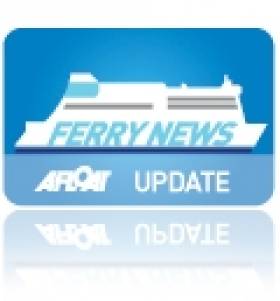Displaying items by tag: Sealink
Second Stena ‘Superfast’ Ferry is Underway from Poland
The new route to Loch Ryan Port, Cairnryan includes a new £80m ferryport terminal which will be served by the 30,000 gross tonnes sisters, the largest ever ferries on the North Channel. Stena Superfast VIII is currently in the Skagerrak off northern Denmark and follows her sister Stena Superfast VII which arrived over the weekend, having also undergone refurbishment at the Romentowa shipyard.
The relocation of Scottish terminal from Stranraer to Loch Ryan Port is seven miles closer to the open sea and sailing times are to be reduced to 2hrs and 15minutes. The new terminal is to be officially opened on 25th November when First Minister of Scotland Alex Salmond and Deputy First Minister of Northern Ireland Martin McGuinness will join Dan Sten Olsson, Chairman of Stena Line.
As for the 15,229 gross tonnes Stena Navigator, she made her Stranraer-Belfast sailing yesterday, after de-storing at the VT4 ferry terminal, only completed in 2008, she proceeded to berth at Albert Quay, the location of the former city-centre ferry terminal.
In the interim period to the opening of the new Belfast-Cairnryan route, the sailing schedule on the Belfast-Stranraer service are been maintained by another conventional ferry, Stena Caledonia and fast sailings by the HSS Stena Voyager.
HSS Stena Voyager is expected to lay-up at VT4 after making final sailings to and from Stranraer this Sunday. It is expected Stena Caledonia will also be withdrawn that day and berth at Albert Quay. In the process she will pass Harland & Wolf shipyard, where she was launched in 1981 as the St. David, the last of the quartet of Saint-class ferries commissioend for Sealink/British Rail.
The career of Stena Navigator on the North Channel was short as she only entered service two years ago. She was built in 1984 as Champs Elysees first served for SNCF/Sealink's jointly run Dover-Calais route, followed by a brief spell under Stena Line as Stena Parisien on Newhaven-Dieppe sailings.
She returned to the Straits of Dover route but this time as SeaFrance Manet under the control of SeaFrance. In 2008 SeaFrance introduced SeaFrance Moliere, the former Superfast X, ironically another sister of Stena Line's 'Superfast' ships. This Superfast vessel along with two custom built newbuilds entered SeaFrance service in recent years which led to the eventual replacement of SeaFrance Renoir and her half sister SeaFrance Manet.
- Port of Belfast
- Stena Line
- Ports and Shipping News
- Ferry news
- Loch Ryan Port
- HSS Stena Voyager
- St. David
- SeaFrance
- DoverCalais
- Belfast Lough News
- Sealink
- H&W
- BelfastCairnryan
- Stena Superfast sisters
- Loch Ryan Port Cairnryan
- Romentowa
- Harland & Wolf
- Sealink/British Rail
- SaintClass sisters
- SNCF
- Straits of Dover
- Attica
- VT4 Terminal
- Loch Ryan Scotland
- Sealink British Rail
Irish Ferries Signs 10-Year Contract On Welsh Route
The St. Georges channel crossing carries over 300,000 passengers and 80,000 freight annually and is served by the 34,031grt Isle of Inishmore. The ro-pax can handle 2,200 passengers, 802 cars / 152 freight trailers and is scheduled to two daily round trips, on a route that take nearly five hours.
The 1997 Dutch built vessel was first launched onto the central corridor route between Dublin-Holyhead but was transferred to the southern service after the introduction of Ulysses in 2001.
Rosslare-Pembroke Dock sailings only began in 1980, firstly operated by the B+I Line which competed with rival operators Sealink / British Rail (now Stena Line) on services running out of Fishguard.
This route was well established having started operations in 1906 and in an era when the railway companies (in this case the Great Western Railway) developed and owned the ports plus the operation of shipping services on the Irish Sea.






























































